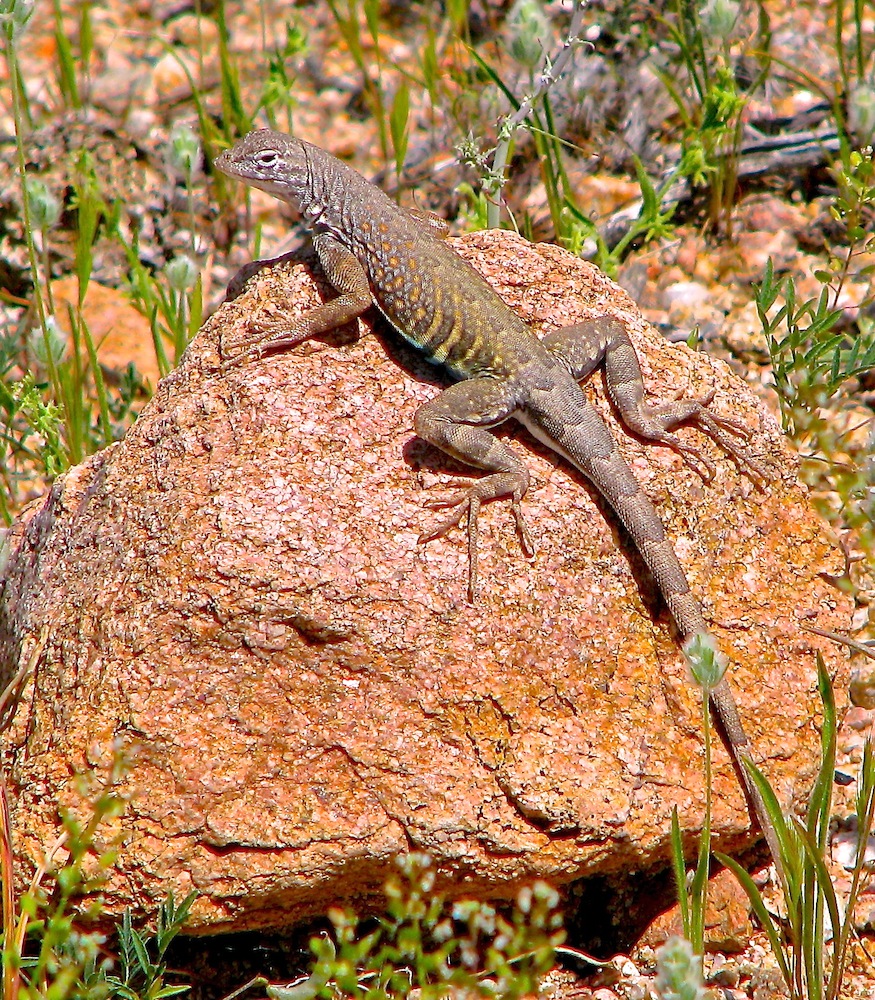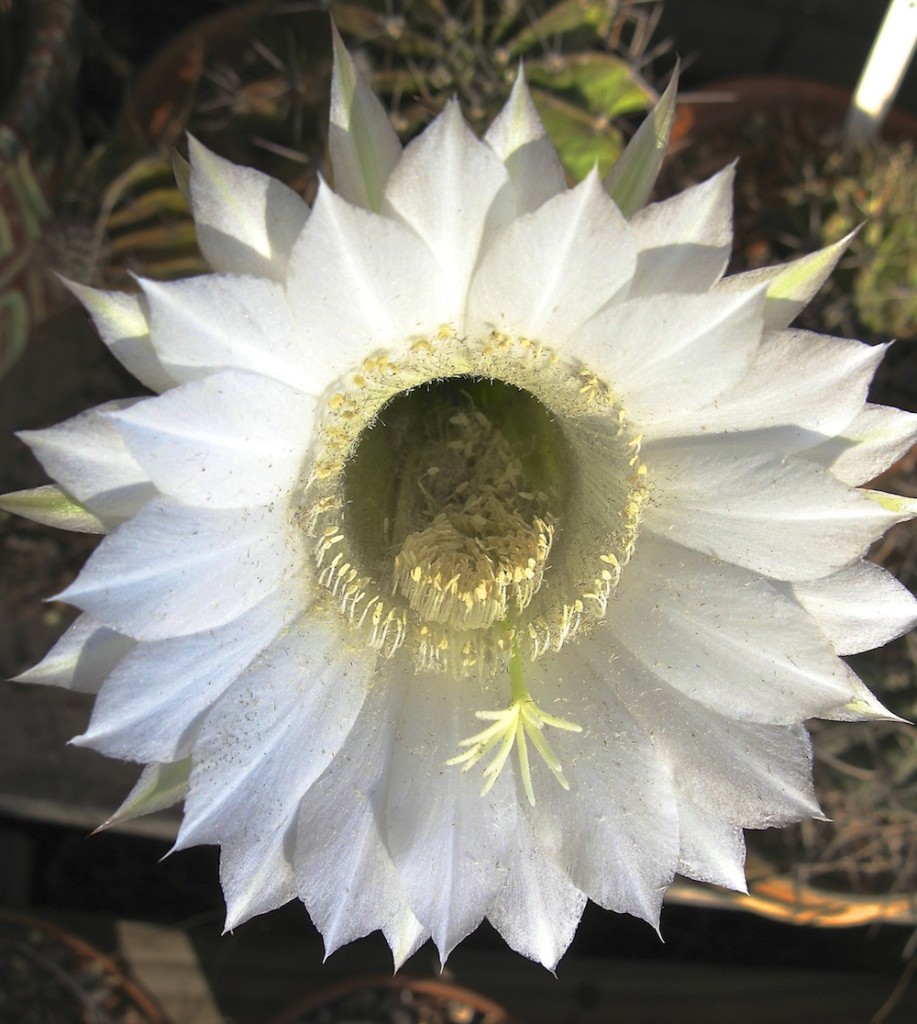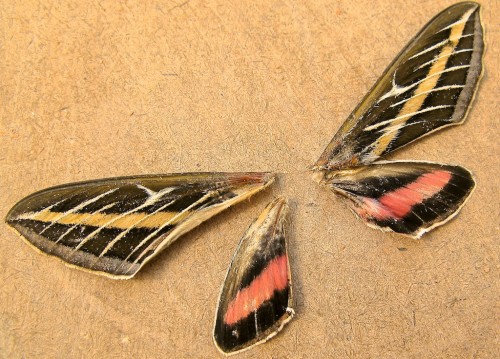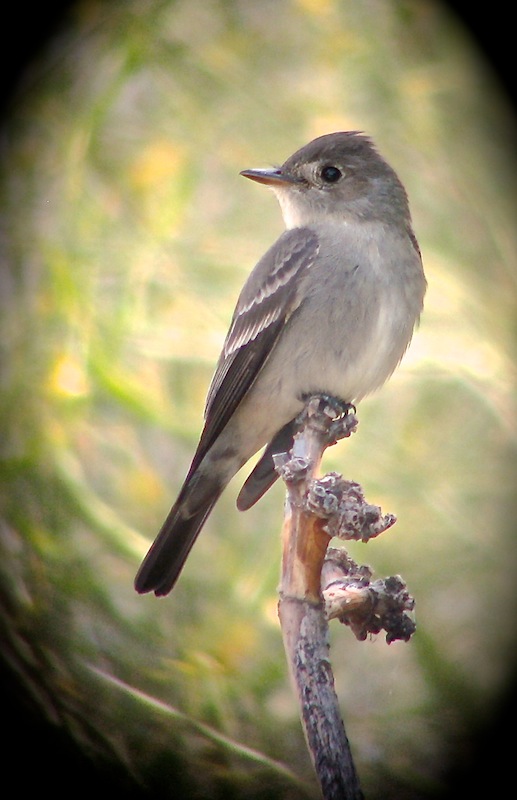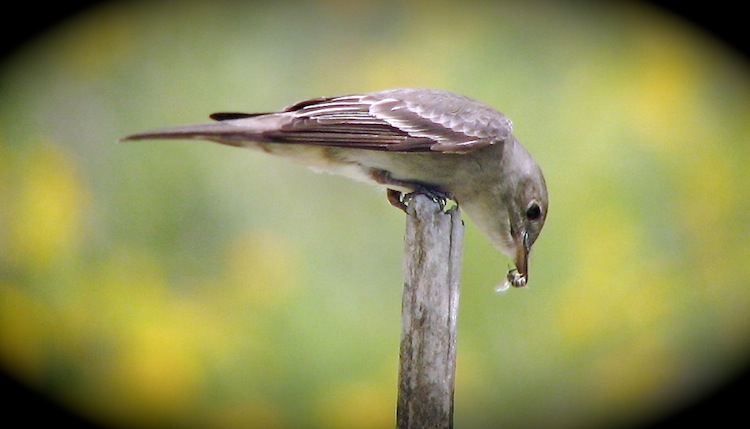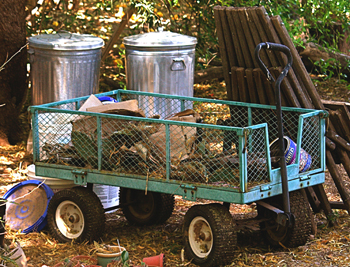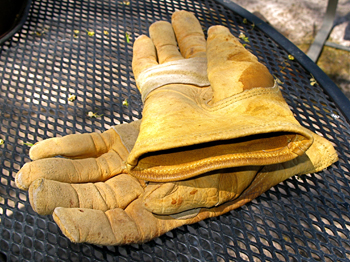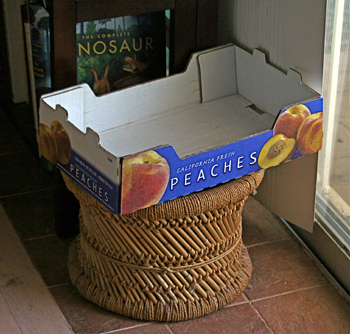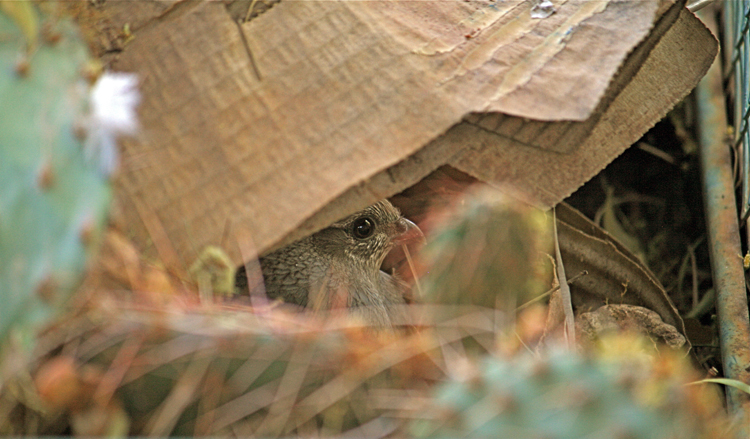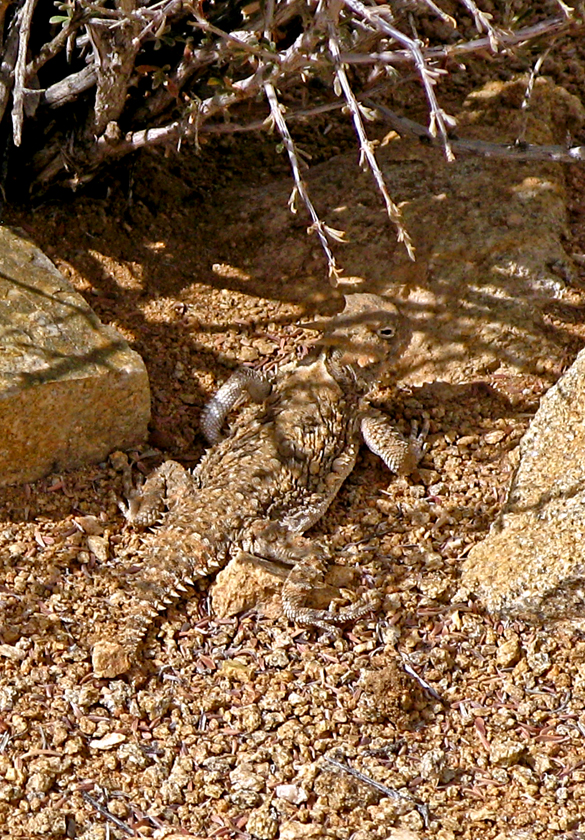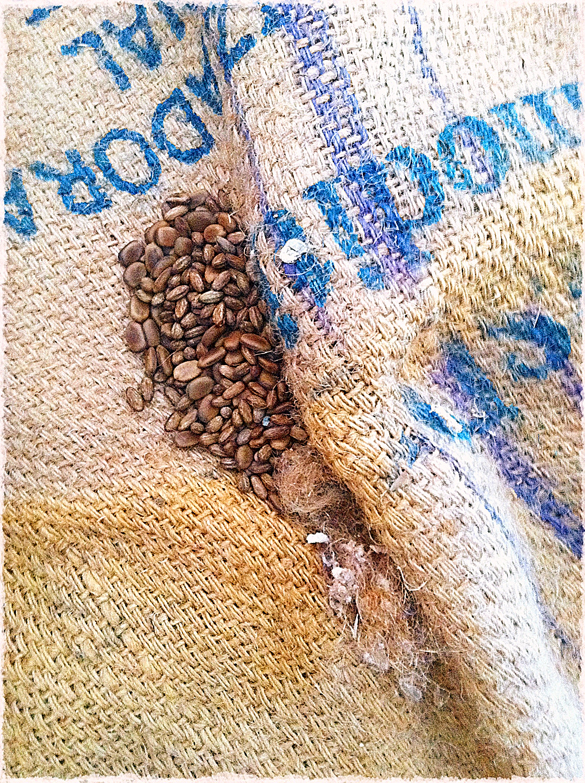Dragon-wing rug
If you had a dragon-wing rug — I do mean a rug made out of dragon wings — and it was terribly old and worn but still in use in the family home, and it lay on the floor of a room at the back with a couple of big armchairs to fold up in and lots of dark wooden bookshelves and not many windows, the rug would probably have fringy bits along the edges, and worn patches where you could see leathery underlayments where the scaly feathers attached, and it might still glitter a little with rainbow membranes. In fact it might look a lot like this:
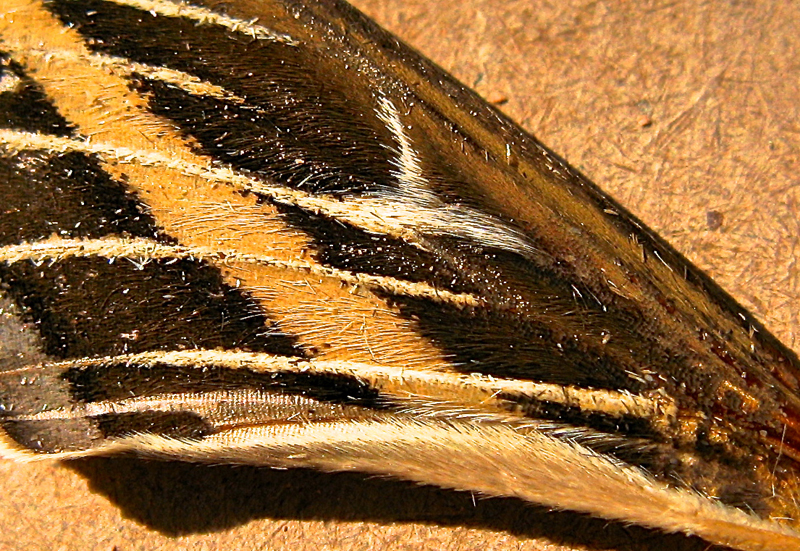
White-lined sphinx moth wing detail
This isn’t a dragon wing, it’s the wing of a sphinx (a mystical and legendary creature in itself) but in this case the moth version. All four of the moth’s wings were discarded by an ærial predator over our yard last night, and all four wings fluttered to the 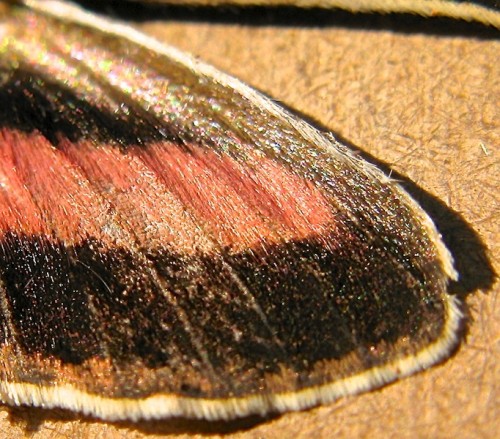 ground and settled within feet of each other. An owl, or a bat, or a nighthawk had shucked it, perhaps — the body would have made a fat protein-rich mouthful but the wings are dry and awkward to swallow, so the predator neatly clipped them and let them fall.
ground and settled within feet of each other. An owl, or a bat, or a nighthawk had shucked it, perhaps — the body would have made a fat protein-rich mouthful but the wings are dry and awkward to swallow, so the predator neatly clipped them and let them fall.
Given this scenario of on-the-wing food prep, the question remains — if you had a dragon-wing rug — what sort of hunter could do that to a dragon?
(All photos A.Shock, click to enlarge!)
Old bird, new spelling
Apparently, it’s spelled Wood-Pewee. And, no, it’s not that the American Ornithological* Union has changed its mind (although that’s been known to happen) — it’s that after decades of birding, I just learned how to spell “Pewee”. All this time I thought it was “Peewee”.
That’s a good thing about birding: refresh, reset, renew.
Even if it’s only orthographic renewal.
>> right, Migrating Western Wood-Pewee (Contopus sordidulus). Below: same bird with a bee for lunch. (Photos A.Shock, digiscoped with a 65mm Zeiss spotting scope and my ancient Canon G7 point-and-shoot)
And speaking of needing refreshment, this little guy (or gal) has come from his winter home in Ecuador (or elsewhere in northern or western South America) to rest in our yard for a day, and to tank up on flying insect fuel. He’s on his way to his woodland breeding grounds north and uphill from here, and he could be almost there if he’s headed to Arizona’s Mogollon Rim. Or he could still have a long way to go, if his destination is inland Alaska. I asked him where he was going, but he was too polite to answer with a beakful of bugs.
All the way from South America! I think we can spare him a bee or two.
*Oh, and by the way, it’s “American Ornithologists‘ Union”, not “Ornithological“. Apparently, spelling pewee isn’t the only new thing I learned today.
Further joys of nidification
There are places like this in the garden and around the house:
Laissez faire places, where neglected green wagons fill with garden miscellany, well-worn gloves are left out in the dust, empty peach flats perch forlornly on footstools. These neglected corners are golden places — especially in spring, when things are looking for private spots to nest. The three opportunities above were discovered by hens of one sort or another, females looking for somewhere to hole up with their young, to tuck in their larvæ, to get uninterrupted rest.
<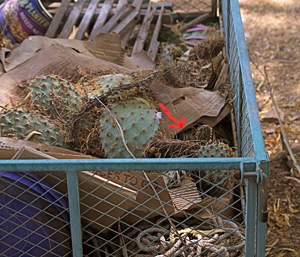 < Nid the First. The small red arrow points to where a Gambel’s quail hen has been sitting tight in the debris in our garden wagon for a few days. She’s easier to spot in the photo below, a tight telephoto of her wary eye from the same angle. I wish her luck: although she’s well-hidden from bumbling humans, we’re not sure how the youngsters will find their way over the sides of the wagon once they hatch. We have a policy of non-interference in these circumstances, but at some point, a ramp may have to be constructed. Update: while the hen was away briefly, it was possible to count 9 eggs in place.
< Nid the First. The small red arrow points to where a Gambel’s quail hen has been sitting tight in the debris in our garden wagon for a few days. She’s easier to spot in the photo below, a tight telephoto of her wary eye from the same angle. I wish her luck: although she’s well-hidden from bumbling humans, we’re not sure how the youngsters will find their way over the sides of the wagon once they hatch. We have a policy of non-interference in these circumstances, but at some point, a ramp may have to be constructed. Update: while the hen was away briefly, it was possible to count 9 eggs in place.
Nid the Second. In the desert, it’s advisable to always look into a shoe before slipping your foot in. The same goes for gloves left outside for a week: E tried to put on a work glove this morning, and found that his fingers didn’t go all the way in. Looking inside, he discovered that a female leaf-cutter bee had found the interiors of the stiff leather fingers just right for stashing her eggs (along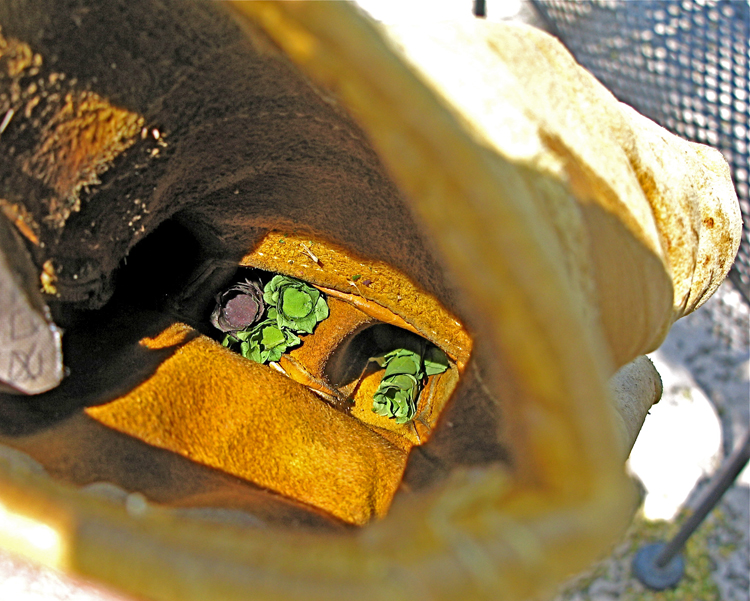 with food for the eventual larvæ) between individually-constructed layers of soft leaves — three green tubes and one purple. The colors of the tubes depend on the bee’s plant selection. A spare pair of gloves in the garage that no one was using enabled E to get the yardwork done, and the nest-glove and its contents were left to hatch or be scavenged.
with food for the eventual larvæ) between individually-constructed layers of soft leaves — three green tubes and one purple. The colors of the tubes depend on the bee’s plant selection. A spare pair of gloves in the garage that no one was using enabled E to get the yardwork done, and the nest-glove and its contents were left to hatch or be scavenged.
Nid the Third. The final nesting location is more domestic, and will not be news to anyone with cats: it’s the simple miracle of a box spontaneously generating a cat of 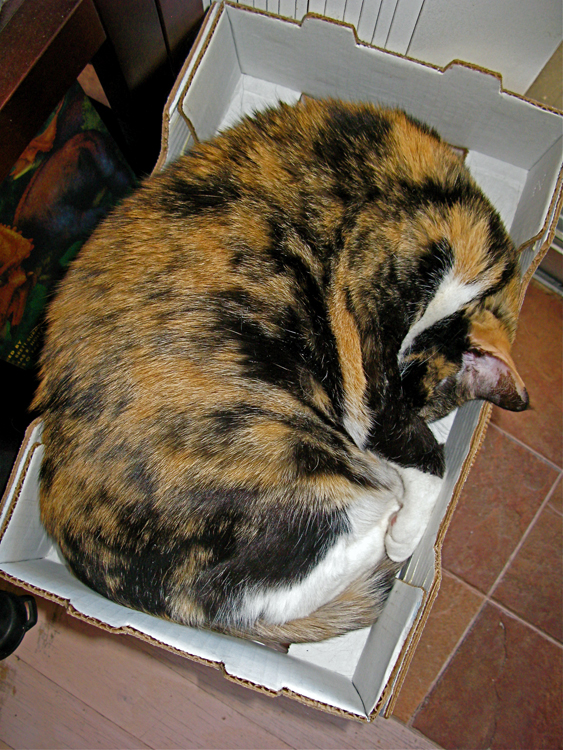 precisely equivalent volume. Here Miss B has condensed in the peach-flat we call the “Summer Palace” since it sits by the sliding glass door, allowing the sights and smells of the back yard to be taken in at leisure, even in sleep.
precisely equivalent volume. Here Miss B has condensed in the peach-flat we call the “Summer Palace” since it sits by the sliding glass door, allowing the sights and smells of the back yard to be taken in at leisure, even in sleep.
With all of these casual nesting choices being made in objects intended for another purpose, I’d like to point out the irony of the fact that the deliberate, pricey nest box we set up for woodpeckers and/or screech owl is unused, so far. Of course: it’s the wildlife correlation to kids ignoring the toy, but playing with the box it came in.
(All photos by A.Shock)
Spot the Bird: horned edition
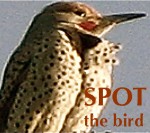 It’s Spot the Bird without a bird. No clues, except that it’s all elbows. Answer below the fold.
It’s Spot the Bird without a bird. No clues, except that it’s all elbows. Answer below the fold.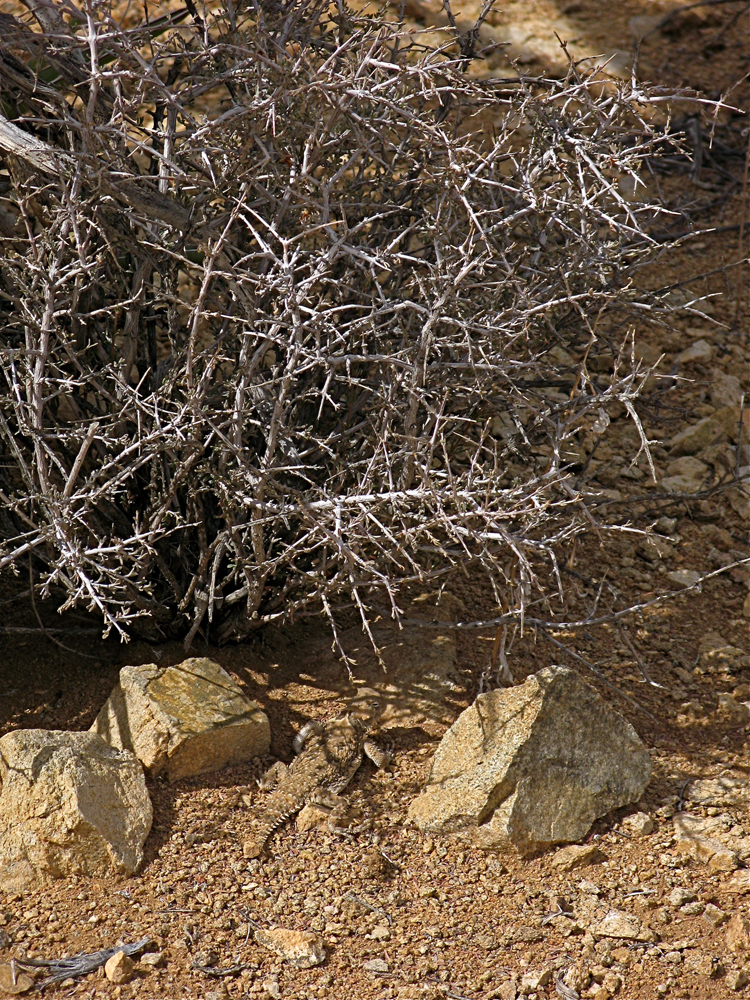
Adult Desert Horned Lizard (Phrynosoma platyrhinos) hiding under a shrub, Joshua Tree National Park (photos A.Shock March 2013)
The desert pops
Lots of rain, sunshine, and warm temperatures after a tough winter have started the desert’s flower-fueled engines, pumping poppies out of “nowhere” like magician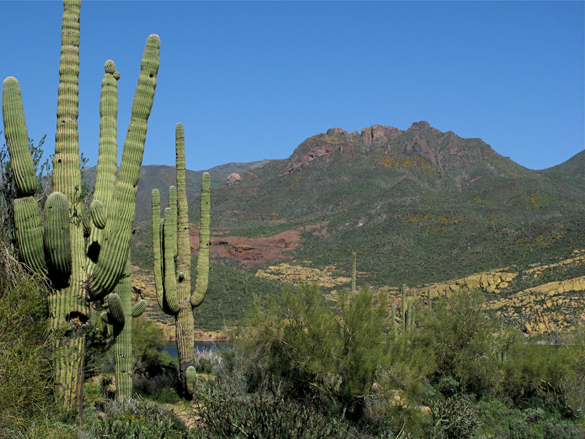 ‘s flowers.
‘s flowers.
<< View across Bartlett Lake to SB Mountain in the Mazatzal Wilderness area. The bright orange wash just below the high peaks is poppy fields. The bright green on the lower right edge of the image is chartreuse lichen on the “Yellow Cliffs”.
E and I entered the flowery fray on Sunday, in search of blooms. The west side of Bartlett Lake was our destination — we realized we’d never been there in all these years — and it was good. To those searching solitude, I should explain that the lake itself is potentially off-putting; not its actual self, or setting, or vistas, which are spectacular, but because on weekends speed boats and jet skis and other motorized etceteræ mix with the sound of the breeze in the saguaro needles, and the blue calm of the water.
and other motorized etceteræ mix with the sound of the breeze in the saguaro needles, and the blue calm of the water.
>> Roadside mix of orange and less common white Mexican Gold Poppy (Eschsholzia californica ssp. mexicana, see last photo below for portrait of a white poppy)
This early in the season this traffic is bearable since it’s nowhere near the height of the boys-with-toys influx and fossil fuel frenzy which will invade after school’s out and with warmer temps. But here you’re on the edge of wilderness, not in it. Fortunately, the shoreside trail we chose to explore was near a non-motorized cove, which meant most of the motorcraft were inaudible on the opposite side of the lake, and the hardy, self-powered paddle-boarders and unexpected numbers of distance swimmers 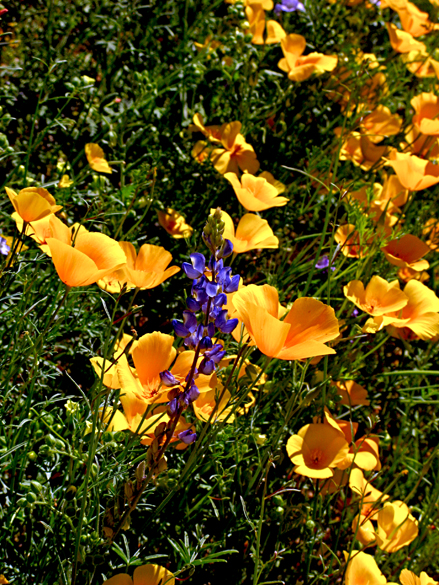 braving the winter-cold riffles were impossible to object to.
braving the winter-cold riffles were impossible to object to.
<< More Mexican gold poppy and Coulter’s Lupine (Lupinus sparsiflorus).
The annual bloom seemed near peak, scattered in the granite gravelly bits among tough perennials like Chuparosa, Brittlebush, Pink Fairy Duster, Buckwheat, and Desert Lavender. The saguaros and other spring-blooming cactus haven’t begun yet here, but the Ocotillo are in leaf, and in a week or two their hot-poker flowers will ignite their branch tips.
New to us was the subtle but spectacular Mentzelia (probably involucrata, Sand Blazing Star), which we missed on the outward bound walk but caught on the back-track — probably because it opened its transluscent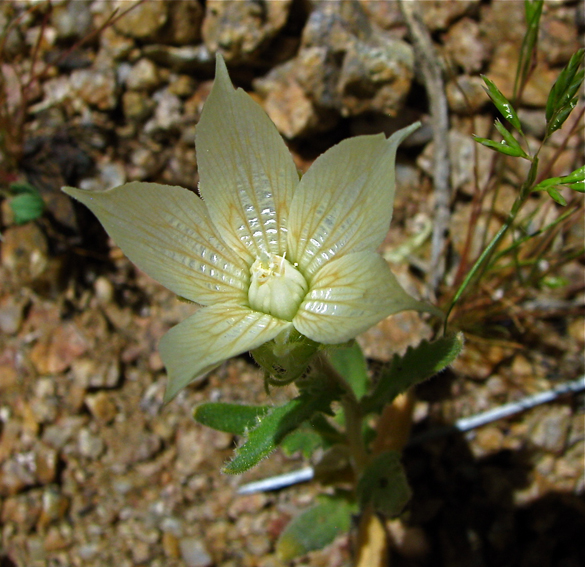 cream-colored flowers mid-morning, after we passed them earlier on. >>
cream-colored flowers mid-morning, after we passed them earlier on. >>
Lizards were the only reptiles we encountered — including the largest Tiger Whiptails I’ve ever seen! — and birds were active with spring pursuits. Most were “the usual suspects”: the locals like Northern Cardinals, Verdin, Rock and Cactus Wren, Common Ravens, an American Kestrel hunting for shoreline grasshoppers from a lake-side snag. There were some newly-returned breeders, like a Bell’s Vireo emitting its chewy song from within the brush, Black-tailed Gnatcatchers, Ash-throated Flycatcher, and a spectacular male Vermilion Flycatcher performing his rising, stalling, and calling nuptial flight, glowing red like a stoplight against the blue sky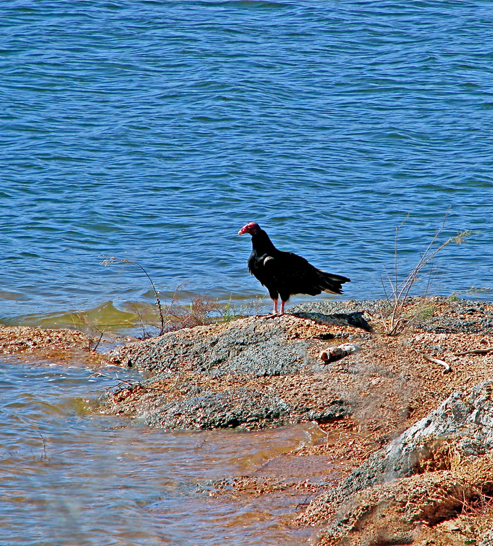 (click here to view an excellent slo-mo video of a male feeding). There was even a Turkey Vulture doing an impression of a shorebird (photo E.Shock)>>
(click here to view an excellent slo-mo video of a male feeding). There was even a Turkey Vulture doing an impression of a shorebird (photo E.Shock)>>
Chia buds were up and only beginning to open, but the curled necks of purplish Scorpion weed (Phacelia ambigua, below) nodded over the trail in places, as well as Woolly Daisies, two species of Camissonia, Whispering Bells, Fiddleneck, Blue dicks, Gilia, Cream cups, and Desert Marigold.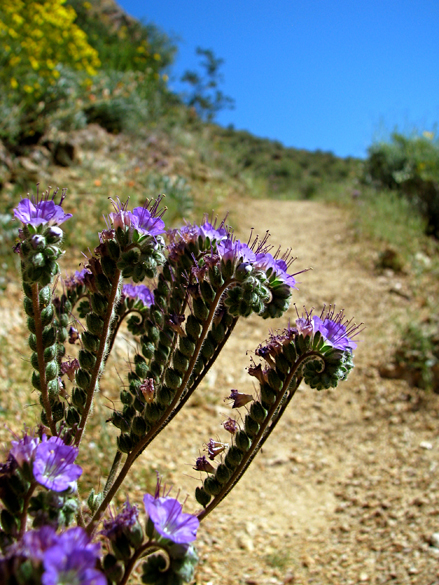
<< Scorpion weed (photo E.Shock)
About three roundtrip miles of hiking and a trip up the road yielded around twenty species of annuals either in bloom or about to bloom (no doubt more for those with more expertise).
For dessert, below is a close-up of a fully open, satiny white poppy, agitated by both bees and the breeze, dusted with its own pollen.
(All photos by A.Shock, unless noted. Be sure to click on each, in some cases to enlarge, but also because clicked-on images in WordPress generally have better resolution than images embedded in the text.)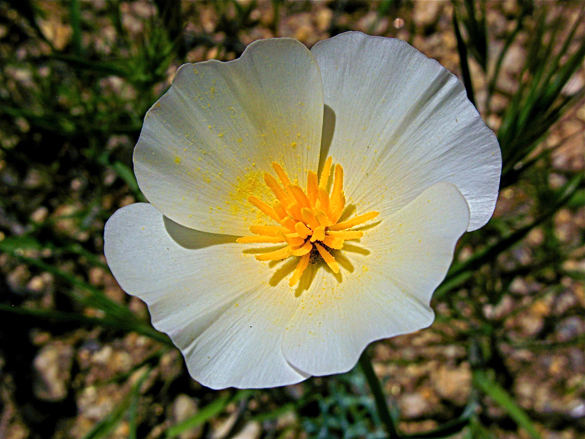
Sphinx in pinks
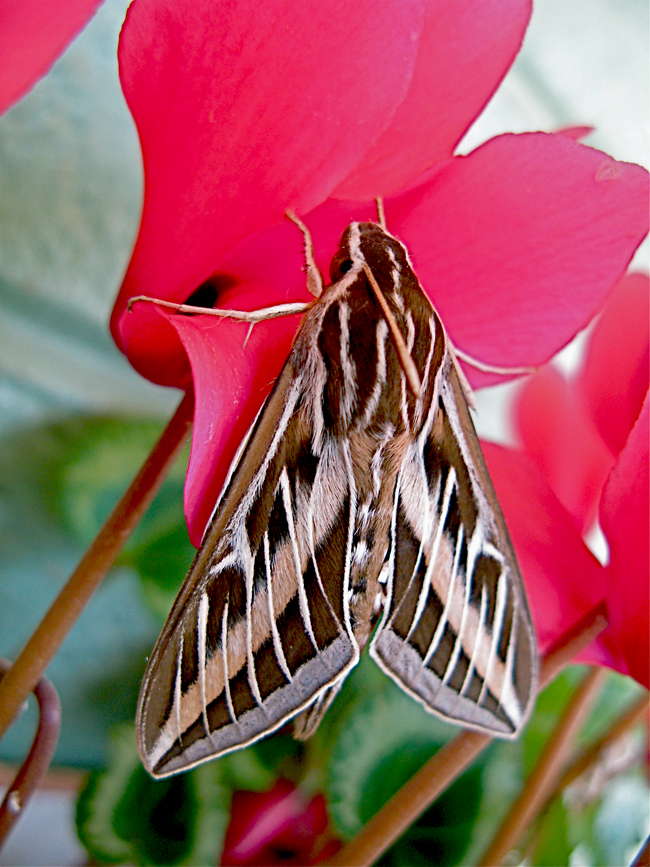 It’s springtime, and under the fluorescent bulb the front porch metamorphoses into a feeding and mating hotspot. Mantids, huntsmen, sunspiders, cellar spiders, a variety of moths and other jointleggedies and geckos congregate at this arthropodal equivalent of a savannah watering hole to look for love, snacks, and in the case of the mantids, lovesnacks.
It’s springtime, and under the fluorescent bulb the front porch metamorphoses into a feeding and mating hotspot. Mantids, huntsmen, sunspiders, cellar spiders, a variety of moths and other jointleggedies and geckos congregate at this arthropodal equivalent of a savannah watering hole to look for love, snacks, and in the case of the mantids, lovesnacks.
The showy barflies of the moment are the sphinx moths — I believe these are White-lined Sphinxes, Hyles lineata, also known as hummingbird moths — two of whom have been flirting on the front door screen by night and roosting under the eves during the day. Last night one chose the Cyclamen in a wall pot for its dayroost, and was a patient subject for close-ups in the morning. (By the way, the outrageous saturation of the pink cyclamen is not artificially boosted — in fact, I had to tone it down a bit because it actually hurt to look at.)
The sphinges hover at flowers like Evening primrose (which aren’t in bloom yet around the yard) and this hovering habit along 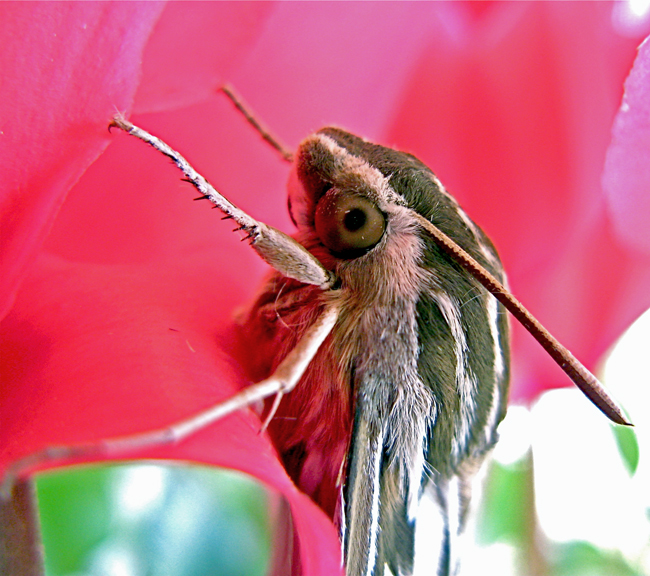 with their large size (nearly 2 inches long) and feathery-looking body covering give them their nickname of hummingbird moths. But look at the portrait on the left — they’ve got big nocturnal eyes, which look more owly than hummery to me.
with their large size (nearly 2 inches long) and feathery-looking body covering give them their nickname of hummingbird moths. But look at the portrait on the left — they’ve got big nocturnal eyes, which look more owly than hummery to me.
Check out another sphinx moth here, the rustic sphinx whose larvæ feed on Desert willow and tecoma.
(Photos A.Shock, be sure to click to enlarge)
The Others Who Live in Our House
We have a loose house.
By that I mean that nothing — windows, roof, doors, plumbing — closes tight, seals off, keeps in, or shuts out. Anything. Everything — cold draughts, hot breezes, swirling dust, muddy floodwater, joint-leggedies, fur bodies, helicopter rotor din — it all comes in, then usually goes out again, unless it decides it’s nice enough to stay, or the cats find it.
From many angles, this is not ideal. But it’s never boring. We call it “living close to nature” and try to learn to appreciate having wasps’ nests in the door jambs, rock squirrels in the attic, leaf-cutter bees in the keyholes, Huntsmen and Cellar spiders at the top of the walls, praying mantises on the houseplants, and termites in the kitchen door frame. OK, to be honest, we haven’t yet learned to appreciate termites in the kitchen, although we haven’t evicted their larval selves yet, either. You get used to inroads, after a while.
>> Palo verde seeds of two types (photo A.Shock)
We uncovered the latest inroad yesterday while searching for a bag of sawdust in the garage: someone’s carefully harvested, cleaned, and stored seed hoard. It featured two different kinds of seeds, Blue Palo Verde and Little-leaf Palo Verde, neatly cached with a little fuzzed fiber as a casually engineered plug to keep the treasure from flowing down the fold of a burlap bag. It was nice work: no husks, droppings, or other pollution in sight. But no owner, either. It was probably one of the Other Mice, family Heteromyidæ, a pocket mouse or kangaroo rat (neither is either a rat or a mouse), most likely the former, which we see around the yard. Caches like this are generally stored underground, and in addition to nourishing the gatherers, provide one of the main ways Palo Verde trees propagate: seeds in a rodent’s forgotten subterranean hoard will germinate, just add monsoon rains. But this trove was high and dry, and the seeds would have languished without benefitting the tree.
And maybe not the pocket mouse who stuffed it into our loose garage, either. But we’ll never know — the human need for not sharing living space with chewing organisms (except dogs, for some reason) kicked in and we scooped up the hoard and spirited it away — a full 1/3 of a cup of pretty little hard, brown seedlets, the smallest ones speckled like the beans they are. Their fate is to be determined. I read that you can bake bread with palo verde seeds: like most legumes, they’re very nutritious. After all the rodent’s hard work, it seems like someone should eat them.
Now, does anyone have a recipe for termites?

